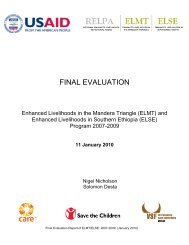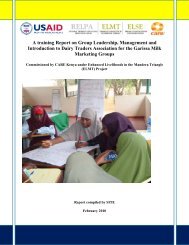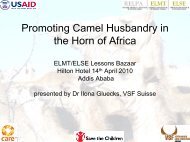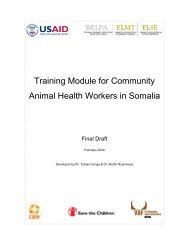Impact Assessment of the Community Animal Health System in ...
Impact Assessment of the Community Animal Health System in ...
Impact Assessment of the Community Animal Health System in ...
You also want an ePaper? Increase the reach of your titles
YUMPU automatically turns print PDFs into web optimized ePapers that Google loves.
y <strong>the</strong> Office <strong>in</strong>ternational des epizooties (OIE), us<strong>in</strong>g report<strong>in</strong>g forms developed by VSF Suisse and<br />
submitt<strong>in</strong>g <strong>the</strong>m to <strong>the</strong> DVO each month. The system started <strong>in</strong> May 2009 and up to <strong>the</strong> end <strong>of</strong> July<br />
2009 <strong>the</strong> CAHWs submitted seven disease outbreak reports.<br />
3.4 Quality <strong>of</strong> CAHW treatments<br />
A summary <strong>of</strong> <strong>the</strong> impact <strong>of</strong> CAHW treatments on CFRs is presented <strong>in</strong> Table 2.<br />
Table 2. Statistical and cl<strong>in</strong>ical reductions <strong>in</strong> case fatality rates <strong>in</strong> livestock herds treated by CAHWs compared<br />
with owner‐treated herds<br />
Curative or<br />
supportive<br />
treatments by<br />
disease<br />
Sheep and goats Camels Cattle All species<br />
Statistical<br />
reduction<br />
<strong>in</strong> CFR<br />
Cl<strong>in</strong>ical<br />
reduction<br />
<strong>in</strong> CFR<br />
Statistical<br />
reduction<br />
<strong>in</strong> CFR<br />
Cl<strong>in</strong>ical<br />
reduction<br />
<strong>in</strong> CFR<br />
Statistical<br />
reduction<br />
<strong>in</strong> CFR<br />
Cl<strong>in</strong>ical<br />
reduction<br />
<strong>in</strong> CFR<br />
Statistical<br />
reduction<br />
<strong>in</strong> CFR<br />
Cl<strong>in</strong>ical<br />
reduction<br />
<strong>in</strong> CFR<br />
Curative:<br />
Helm<strong>in</strong>thosis<br />
Mange<br />
Trypanosomosis<br />
CCPP<br />
CBPP<br />
Respiratory disease<br />
Tick‐borne disease<br />
Total<br />
Yes<br />
Yes<br />
‐<br />
Yes<br />
‐<br />
‐<br />
No<br />
Yes<br />
Yes<br />
‐<br />
Yes<br />
‐<br />
‐<br />
Yes<br />
Yes<br />
Yes<br />
No<br />
‐<br />
‐<br />
Yes<br />
‐<br />
Yes<br />
Yes<br />
Yes<br />
‐<br />
‐<br />
Yes<br />
‐<br />
Yes<br />
‐<br />
Yes<br />
‐<br />
Yes<br />
‐<br />
‐<br />
Yes<br />
‐<br />
Yes<br />
‐<br />
Yes<br />
‐<br />
‐<br />
3/3<br />
2/2<br />
1/2<br />
1/1<br />
1/1<br />
1/1<br />
0/1<br />
9/11<br />
3/3<br />
2/2<br />
2/2<br />
1/1<br />
1/1<br />
1/1<br />
1/1<br />
11/11<br />
Supportive:<br />
Pox diseases<br />
PPR<br />
NSD<br />
FMD<br />
Paralysis, camels<br />
Total<br />
No<br />
No<br />
Yes<br />
‐<br />
‐<br />
Yes<br />
No<br />
Yes<br />
‐<br />
‐<br />
No<br />
‐<br />
‐<br />
‐<br />
No<br />
Yes<br />
‐<br />
‐<br />
‐<br />
Yes<br />
‐<br />
‐<br />
‐<br />
No<br />
‐<br />
‐<br />
‐<br />
‐<br />
No<br />
‐<br />
0/2<br />
0/1<br />
1/1<br />
0/1<br />
0/1<br />
1/6<br />
2/2<br />
0/1<br />
1/1<br />
0/1<br />
1/1<br />
4/6<br />
Notes<br />
Curative treatments aim to kill <strong>the</strong> primary disease agent, such as a bacterium (e.g. through <strong>the</strong> use <strong>of</strong> antibiotic)<br />
or parasite (e.g. through <strong>the</strong> use <strong>of</strong> an<strong>the</strong>lm<strong>in</strong>tic). For most <strong>in</strong>fectious diseases curative treatment should result <strong>in</strong><br />
lower CFRs (fewer deaths) than supportive treatments.<br />
Supportive treatments, <strong>in</strong> <strong>the</strong> context <strong>of</strong> this assessment, ma<strong>in</strong>ly <strong>in</strong>volved <strong>the</strong> use <strong>of</strong> antibiotics to treat bacterial<br />
<strong>in</strong>fections which were secondary to viral <strong>in</strong>fections. This approach is used when anti‐viral drugs are not available<br />
and assumes that some deaths result from <strong>the</strong> secondary bacterial <strong>in</strong>fections. As <strong>the</strong> primary cause <strong>of</strong> disease is<br />
not treated, <strong>in</strong> general, supportive treatments result <strong>in</strong> higher CFRs (more deaths) than curative treatments.<br />
Case fatality rates <strong>in</strong> sheep and goats<br />
CAHWs provided curative treatments for four diseases or disease groups viz. contagious capr<strong>in</strong>e<br />
pleuronemonia (CCPP), mange, helm<strong>in</strong>thosis and protozoal tick‐borne diseases, and supportive<br />
treatments for three diseases viz. Nairobi sheep disease (NSD), sheep and goat pox and peste des<br />
petits rum<strong>in</strong>ants (PPR)(Table 3).<br />
For three out <strong>of</strong> four diseases where curative treatments were used by CAHWs, CFRs were<br />
significantly lower <strong>in</strong> CAHW‐treated cases relative to cases treated by livestock keepers. CAHWtreated<br />
cases <strong>of</strong> NSD also showed a significantly lower CFR relative to cases treated by livestock<br />
keepers. Fur<strong>the</strong>rmore, <strong>the</strong>se median reductions <strong>in</strong> CFR were substantial: 31.6% for CCPP; 33.3% for<br />
mange; 21.4% for helm<strong>in</strong>thosis and 33.9% for NSD. For tick‐borne disease, sheep and goat pox, and<br />
‘o<strong>the</strong>r diseases’, CFRs were lower <strong>in</strong> CAHW‐treated herds. Compared with CFRs <strong>in</strong> owner‐treated<br />
8












